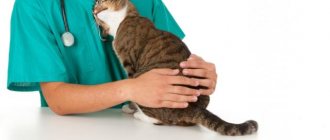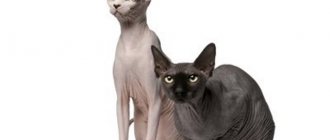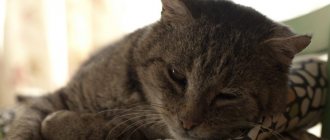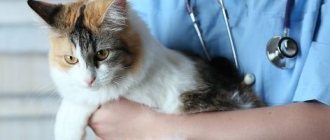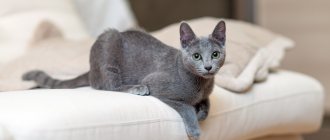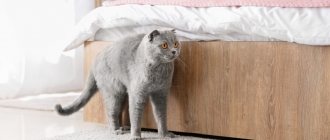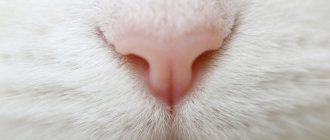For cats, the nose is a significant tool in exploring the world around them. An excellent sense of smell helps cats navigate space through smells, warm and clean the air from small debris, dust particles and microbes.
Unfortunately, a cat cannot always attract the attention of its owner to the problem that worries it: the ancient instinct of a predator does not allow animals to show their weakness. For this reason, cats' noses have become susceptible to many myths about animal health, but at the same time can signal possible problems. In this article, we figured out what a healthy cat’s nose should be like and for what reasons it can be hot. You will also learn which symptoms require urgent attention, how to diagnose and what to do next.
What should a healthy cat's nose look like?
From the very first days of its life, a blind and deaf kitten relies only on its sense of smell: with its help, it finds its littermates, and its sense of smell helps to find the milky smell of its mother’s nipples. Throughout its life, the animal studies space through the nose, which means this organ, being one of the most active, can say a lot about the pet’s health.
Let's look at the structure of the cat's nose: it consists of two nasal entrances, separated by a cartilaginous septum, behind them begin the “ethmoid conchae” - a complex structure that allows cats to retain a certain smell in the corners of the shell and separate it from impurities for more accurate identification.
Structure of a cat's nose
Having passed through this complex structure, the odor molecules irritate the sensitive cells in the olfactory center of the nose, which helps the cat recognize the aroma and remember it.
IMPORTANT: a cat’s nose is 15 times more sensitive than a human’s and has about 80,000,000 receptors.
Smells that are familiar to humans can be very pungent for a cat: the smell of perfumes, spices, and citrus fruits will cause sneezing, and the animal will begin to rub and hide its nose.
Most often, animal owners observe the nose - a soft “button” on the animal’s face that everyone tries to touch. It is no coincidence that the nose is called a “mirror”: throughout your pet’s life, you can note what the cat “sees” with this organ.
Healthy nose
IMPORTANT: in a healthy state, the cat’s nose is slightly wet, not hotter than the animal’s body temperature. There are no pathogenic inclusions in the form of wounds, crusts, or obvious cloudy discharge.
Why does a cat's nose sometimes become a little wetter? The fact is that the nose secretes a special lubricant, the moisture of which protects the nasal passages from drying out. In addition, cats often deliberately lick their already wet nose.
In addition to its direct olfactory function, a cat’s nose warms and purifies the air it inhales; the skin of the nose is very sensitive and helps the animal determine the temperature of food, objects and surfaces without touching.
The color of the “mirror” of the nose matches the color of the fur on the muzzle; pigment spots may be present on it; the nose of an adult cat can also turn black with age. The black coloration of the nose makes it more difficult to identify a potential health problem; in this case, you can examine the mucous membranes of the mouth and eyelids. A light, almost white nose in cats most clearly demonstrates a possible illness, since blood vessels are clearly visible through it.
Black nose
Light, almost white nose
Pigmentation on the nose
Cases of non-dangerous deviations from the norm
- When Murka sleeps. After all, at this time she does not lick her muzzle, and the glandular cells hardly produce phlegm. The nose can remain dry and warm for another half hour or hour after sleep.
- Kittens, like... little guys, have unstable thermoregulation, so their body temperature is often elevated. For example, after sleep, games, meals, and even depends on the mood. It happens that the mother does not lick the baby thoroughly. Then the owner himself will have to wash it several times a day with a napkin with warm and boiled water.
- In winter, radiators in our homes both heat and reduce air humidity.
- Mild and short-term illness of the pet (overeating, excess hair getting into the stomach, etc.), stress or fear, pregnancy, childbirth, etc.
- Active and moving activities when the body warms up.
- Hot and muggy environment. But, after the end of unfavorable conditions, everything also returns to normal for the cat.
- The advanced age of the animal, during which metabolism slows down, and therefore... the nose is almost always dry and warm.
- So, for all these reasons (except for No. 7), the animal’s olfactory organ does not remain dry and warm for long. And if for a long time and, especially, other symptoms of trouble in the body are present, this sign portends serious illnesses. Which?
Should I worry?
If you are convinced that everything is in order with the cat’s health, the animal’s nose does not need additional care. Health problems are excluded by clinical diagnosis in a veterinary clinic, regular care of the animal, good nutrition and routine vaccination, deworming, cleaning from fleas and other parasites.
IMPORTANT: if you find a warm, dry nose on a cat, leave the animal for a while and touch the nose again. If you find other alarming symptoms, consult a specialist!
Treatment of burns of ENT organs
Even when it seems that the damage is minor, it is better to see an otolaryngologist. If the injury occurred due to contact with a complex chemical compound or an aggressive cleaning agent, then take the packaging with you. A specialist will study the composition of the substance.
For severe burns, antishock medications are indicated. If breathing is difficult, there is severe swelling, prednisolone or calcium chloride is used.
A tracheostomy is performed to restore breathing.
Medical appointments are conducted by ENT specialists with almost 10 years of experience. At your appointment, you will be treated with affected tissues and mucous membranes, and a pain reliever will be selected. If necessary, they will arrange a consultation with a surgeon or refer you to a hospital. The center is open all week, seven days a week.
Features of the animal's condition
In a normal state, the animal’s lifestyle does not change. Minor changes in the appearance of the nose can be caused by external factors and resolve on their own. In this case, the animal helps itself: it washes itself, licks and moisturizes its nose. The pet remains active, eats well, plays a lot and shows affection to its owner.
In the presence of pathology, the animal’s behavior changes
IMPORTANT: make sure that the animal always has fresh and clean water, and that the room maintains a comfortable temperature.
Diagnostics
Only a doctor can diagnose the presence of infection based on the results of a staphylococcus test.
It is worth remembering that testing is recommended only if symptoms of the disease are present. The presence of bacteria in biological material may mean that a person is its carrier, which in itself is the norm.
For analysis, material is taken from the area where the infection is believed to be developing. To detect a pathological process, several tests are carried out to track the dynamics of bacterial growth. If their number increases rapidly, the presence of a staphylococcal infection can be diagnosed. Also, additional analysis will determine the specific type of infection so that the doctor can choose a personal treatment regimen.
Kitten has a hot nose
A hot nose in kittens is most often a sign of their playfulness and increased activity. They run a lot, play, are very curious and try to quickly explore the world around them. A warm and dry nose in this case is not a cause for concern.
Increased activity can cause temporary dry nose in a kitten.
But if you notice that the kitten’s nose remains dry throughout the day, or purulent discharge appears, contact a specialist. Such signs may indicate the occurrence of rhinitis, as well as neoplasms in the nasal passages and sinuses.
Show increased attention to your baby: at an early age, foreign bodies may enter the nasal cavity.
How to care for a cat's nose
Usually, a cat takes excellent care of its nose on its own. The need for cat nose care appears when there is discharge, as well as in breeds with flattened faces.
The nose is cleaned with cotton swabs or soft napkins soaked in water, in the direction from the nose to its wings (from the center to the periphery). It is very important not to apply pressure, use unscented wipes, soft cloth; if there are crusts, they are moistened and removed. A cat's nose is very delicate and sensitive, so you need to act extremely gently and carefully; otherwise, your sense of smell may suffer.
Sometimes, especially in cats of exotic breeds, there is a need to rinse the nose. In this case, after caring for the nose, 1 ml of warm saline solution (0.9% NaCl) is drawn into a small syringe without a needle, an assistant is assigned to hold the cat, and 0.5 ml is injected into each nostril. The cat will begin to sneeze and the nasal passages will begin to clear.
How to examine an animal yourself?
First, pay attention to the color of your nose and oral mucosa. Touch the paws and inspect them for redness.
IMPORTANT: if the nose is black, inspect the eyelids and the surface of the mucous membrane in the animal’s mouth.
This is what anemia looks like on the oral mucosa
– pallor of the mucous membrane occurs with hypothermia, the development of anemia, the initial stage of poisoning;
– yellow color of the mucous membrane indicates liver disease;
– bluish color of the mucous membrane may indicate a malfunction of the heart;
– redness is characterized by infections, inflammations, allergies, increased temperature and pressure.
Next, using a stopwatch, you can measure the cat's pulse from the inside of the thigh. Feel the pulsation and count the tremors for 15 seconds. Multiply the sum of calculations by 6, so you will determine the number of beats per minute.
An example of how to measure a cat's pulse at home
IMPORTANT: the animal’s normal pulse is no more than 140 beats per minute. The animal's pulse may change during the mating season.
What is the danger
- If the mucous membranes of the throat or nose are affected, there is a high probability of swelling. It spreads quickly and makes breathing difficult. Up to the point of suffocation.
- When ingested or inhaled vapors of acids and alkalis, damage to the nasopharynx and throat is usually combined with deeper damage to the trachea, esophagus and other internal organs. Necrosis of esophageal tissue and perforation are possible.
- External burns cause intoxication and take a long time to heal without proper treatment. The wound surface becomes infected.
- If the lesions are strong and extensive, a painful shock occurs.
How to take your pet's temperature
Enlist the help of a person to whom the animal is friendly - this will make it easier to measure the cat’s body temperature. Be gentle, do not make sudden movements, lull and stroke the animal.
An electric thermometer will give the most accurate readings
IMPORTANT: the cat must have its own individual electric thermometer. Body temperature is measured through the anus of the animal and should not exceed the limit of 38-39 degrees.
Take a thermometer, disinfect it, treat it with Vaseline to soften the passage. Place the cat on a hard surface, you can calmly grab the animal with your hands and fix it. Carefully place the thermometer 2 cm into the anus. Calm and stroke the cat, hold the thermometer for the right time (the electric thermometer will notify you yourself).After manipulations, re-disinfect the thermometer and place it in the first aid kit.
Causes
Most often, the bacterium enters the human body through wounds and microcracks in the skin. The infection, having penetrated through the wound, begins to multiply in the blood, spreading throughout the body and affecting the lungs, heart, brain, liver, kidneys, and joints.
With staphylococcus, diseases can be very different, such as pneumonia, meningitis, osteomyelitis, endocarditis, sepsis and many others.
Staphylococcus infection can occur in the following ways:
● Through contact and household use when using the patient’s personal items;
● Airborne droplets during close contact with an infected person;
● Fecal-oral on dirty fruits, vegetables and other food products, dirty dishes and hands;
● Vertical when a child passes through the birth canal of an infected mother during childbirth.
● Infection often occurs during surgery through medical instruments and during various manipulations.
Symptoms that require doctor's attention
Use caution and seek medical attention if you notice any serious changes in your cat's behavior:
– the animal has become lethargic, apathetic, refuses to eat;
– sleeps a lot, does not respond to calls to play, is indifferent to favorite treats and entertainment;
– the cat’s stool becomes more frequent or worse, and vomiting appears;
– increased salivation is observed;
– green nasal discharge and sneezing appeared;
– the animal reacts negatively to an attempt to touch it;
– body temperature is increased, paws and ears turn red and become very hot;
The presence of such symptoms is a reason to immediately visit a veterinary clinic.
Possible diseases
In addition to a dry and warm nose, there are symptoms that require urgent medical attention:
- in case of gastrointestinal disorders (for example, due to failure to digest food after a course of antibiotics): body temperature rises, vomiting, loose stools, weakness, refusal to eat are possible;
- during (very dangerous!) infectious (viral or bacterial) diseases: the first signs are a hot nose and general weakness, the temperature will also rise, there will be a fever, mucous tissues will become inflamed, stool, appetite will be disrupted, etc.;
- due to an illness caused, for example, by ear mites, the kitty will worry, often and intensely scratch its ears and shake its head; if - by subcutaneous mites, then there will be baldness on the face, and also itching, bumps on the skin, appetite will decrease, thirst will increase, and the temperature will rise;
- in the case of cancer: sudden weight loss, swelling, unusual discharge, unpleasant odor, bleeding, difficulty breathing and swallowing, etc.;
- if there are worms that poison the body, the murka usually feels healthy, but her temperature may suddenly rise;
- in case of poisoning of a kitten (its nose will be hot and dry).
What measures should be taken
Only a doctor can diagnose the presence of a dangerous pathology in combination with external signs.
IMPORTANT: if you notice an illness, you can measure the animal’s pulse and temperature - this is the permissible maximum of measures that you can take at home before the veterinarian arrives. Diagnostics and other medical procedures are carried out only by a specialist!
You can help your animal by eliminating external factors that can cause changes in the nose:
- Regulate the heating temperature of the room, and thoroughly dry the animal’s fur after water treatments. Make sure that the cat is in a warm and comfortable environment, this way you will prevent your pet from becoming hypothermic.
- If your pet spends time outside in hot weather, constantly replenish the supply of clean and fresh water, make sure that the cat has access to a cool place. The animal will feel dehydration and will help its body on its own.
IMPORTANT: with a sunburn, the skin on the nose turns red and becomes hot and painful. In this case, Panthenol gel will help you; you should apply it carefully, avoiding getting into the nostrils. Make sure that the animal does not have other alarming symptoms.
A red and sore nose may be a sign of sunburn
- Humidify the indoor air and regularly ventilate the room in which your pet is located.
- Protect your cat from any factors that cause fear or stress in the animal.
- After consulting a veterinarian, you can learn how to clear your pet’s nose of snot and dirt on your own - this way you will make your animal’s life easier. Nasal rinses are purchased at a veterinary pharmacy, and the first rinse is carried out under the supervision of a veterinarian.
- The position of a cat before giving birth requires special attention: the animal is susceptible to stress, pain and emotional outbursts. Monitor the cat's condition, provide care and, if necessary, call a doctor at home.
When hot ears can be a symptom of illness
Hot ears and nose in a cat are not a clear sign that proves the presence of pathology in the animal’s body. To assess your pet’s health, it is necessary to take into account other clinical symptoms, which include:
- change in the shade of the ear (redness, pallor, cyanosis);
- loss of appetite or complete refusal to feed;
- lethargy;
- decreased activity;
- increase in general body temperature.
If one or more of the listed symptoms is present, then the owner needs to find out what it might mean when a cat has hot ears.
Experts identify several pathological factors that lead to a cat's ears becoming hot.
Stress
When cats are stressed, there is a sharp release of hormones into the bloodstream, which leads to an increase in heart rate and increased blood pressure. As a result of accelerated blood flow, the ears of a kitten or adult animal turn red and become hot.
As the pet calms down, its condition and appearance return to normal.
However, prolonged stress will be accompanied by changes in behavior. The cat may become aggressive, nervous, or overly withdrawn. Gradually, this will provoke the development of pathologies of the nervous system, and will also lead to a decrease in immunity.
Ear mite
The cause of hot ears in a cat may be the ear mite Otodectes cynotis. The disease it causes is called otodectosis. Feeding on sulfur and scales of dead epithelium of the external auditory canal, the parasite releases waste products that irritate the skin and cause severe itching.
The cat itches and hits the ears with its paws, which often leads to the appearance of bruises. Other characteristic symptoms of otodectosis are:
- red and hot ears of the cat;
- tarry dark brown discharge from the ears;
- scratches and ulcers;
- anxiety;
- decreased appetite.
Important! Ear mites can affect either one or two ears. But it is necessary to treat both ears at the same time to prevent the spread of the disease.
Most owners know that hot ears on their pet mean they have cat ear mites. However, only a veterinary specialist can make an accurate diagnosis after examination and microscopic examination of the pathological material.
Otitis
With otitis media, inflammatory processes occur in the auricle, which also affect the middle and inner ear. This disease is caused by bacterial pathogenic microflora.
The first sign of otitis media is a deterioration in the pet’s general health. The cat's appetite decreases, the ears and nose become hot, the animal is lethargic and the owners do not know what to do to alleviate the condition. But at the next stage of the disease, characteristic clinical symptoms of otitis media appear, which make it possible to make a diagnosis and begin treatment. These include:
- pain in the ear area (usually worsens when touched);
- hyperemia of the inner surface of the ears;
- refusal of food;
- purulent discharge from the ears.
With unilateral otitis, the cat tilts its head towards the affected organ, sometimes shakes it, and hits the ears with its paws.
Gradually, the general body temperature may rise above 39°C. Lack of treatment leads to inflammation spreading to the membranes of the brain and death.
Trauma and hematoma
If your cat's ears are red and hot to the touch, this may indicate a hematoma. It may be the result of an injury caused by a blow or compression of the auricle. Also, a pet can provoke damage to blood vessels on its own by hitting it with its paw during severe itching or pain.
A characteristic sign of a hematoma is the absence of any discharge from the ears. On palpation you can feel fluctuation.
Unlike other diseases, with a hematoma there is no discharge from the ears. Also, despite the hot ears, the cat’s nose remains wet.
Infections
The cause of hot ears and noses in kittens and adult cats may be infections of bacterial and viral etiology. Only a veterinarian can determine exactly why a cat has a dry and warm nose.
However, owners need to pay attention to the following signs, which are common to all infectious pathologies:
- sudden loss of appetite or anorexia;
- fever;
- inactivity;
- apathy;
- vomiting, diarrhea and other signs of intoxication.
If the kitten is hot or has discharge from the nose or eyes, this means that the baby must be urgently sent to the clinic.
Other diseases
A cold can cause your cat to have a dry, warm nose. The animal experiences lethargy, decreased appetite, and increased body temperature. At the first stage, the cat’s nose is warm, the mucous membrane of the nasal cavity is noticeably dry, and the ears become hot.
Next, transparent serous discharge appears, which is gradually replaced by mucous discharge. Coughing, sneezing, and heart rhythm disturbances may develop.
A dry nose in a cat may be one of the signs of urolithiasis. In this case, there is an increase in blood pressure and the appearance of blood in the urine. In the absence of urination, urgent hospitalization of the animal is necessary.
Advice for caring owners
When communicating with our beloved pet, we don’t need words: we feel their love and affection, observe how playfully and carefree they show their habits, and admire their grace. As creatures of the wild, domestic cats live and experience this world through their baser instincts.
A happy pet creates the world around him through the care of his owner
You can get much closer and learn to understand your pet's signals and behavior by learning basic information about the structure of their amazing organisms. Regular care and attention to your pet will make you a rare guest in the veterinarian's office.
Types of staphylococcal infections
There are several most common types of staphylococci:
● Hemolytic staphylococcus.
Most often, this infection affects the upper respiratory tract, causing purulent sore throat, pharyngitis, tonsillitis, bronchitis and other inflammatory diseases. These bacteria are very resistant and difficult to treat.
● Golden.
This microorganism is extremely resistant to almost all types of penicillin antibiotics, antiseptics, high temperatures, and active direct sunlight. It causes various skin lesions, such as eczema, abscess, boils, lesions of the gastrointestinal tract, upper respiratory tract, mucous membranes, and in the worst case leads to toxic shock.
● Epidermal.
This microorganism lives on the surface of the skin and mucous membranes of any healthy person and does not cause any harm. But, if this bacterium enters the blood of a person with a weakened immune system, which most often occurs during surgical operations, the use of improperly processed instruments, catheters, blood poisoning occurs, which leads to inflammation of the inner lining of the heart.
● Saprophytic.
Despite the fact that this species is the least dangerous, when infected it leads to general intoxication of the body due to the release of dangerous toxins and enzymes during its life processes. These microorganisms often cause inflammation of the urethra and bladder. This is mainly typical for women due to the anatomical features of the structure of their genitourinary system. If left untreated, cystitis leads to kidney inflammation and problems conceiving a child.
